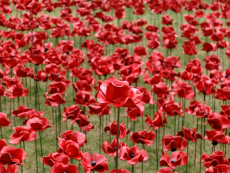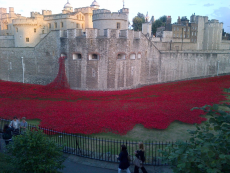
Most will I’m sure be aware of Remembrance Day, celebrated on the 11th of November every year to commemorate the end of the fighting in the First World War in 1914. On this day, we reflect back on those who died while fighting in the war and remember what a sacrifice they made for our country. Amongst the things we associate with this day, the poppy is probably the most iconic. Many buy them to wear in order to pay respects to those who lost their lives and to show support for the Royal British Legion, a charity set up to help those serving in the armed forces. A two minute silence is also carried out on the closest Sunday each year, known as Remembrance Sunday, when everybody stops what they are doing and takes two minutes just to remember those who fought for us and made the life we have today possible. The poppy motif of the day is thought to originate from John McCrae’s war poem ‘In Flanders Fields’, which discusses the red poppies that would grow over the graves of the soldiers who had died. The red colour has now also become associated with the blood of those who died during the war.
The First World War began on the 28th July 1914, and this year is special, since it is the 100th year since the beginning of the war. Because of this, many larger scale memorial events have taken place. One such memorial is an art exhibition taking place at the Tower of London. It is called ‘Blood Swept Lands and Seas of Red’ and is a marvel to behold. It consists of 888,246 ceramic poppies, each of which was hand made by artist Paul Cummins and members of his art team. Each flower in the exhibit was made to represent a person that died during the war, and having each one hand made really creates the feeling that each poppy is unique, just like a person. The poppies were placed within the moat, encircling the Tower of London, leading to a fantastic sight. You really can appreciate the effort that went into making such a large scale event like this happen, and really get a visual representation of how much impact the war had. The placement of the poppies itself was overseen by stage designer Tom Piper.

The area around the tower was particularly full of visitors coming to pay their respect to the soldiers, yet surprisingly there was a feeling of serene quality to the place that can’t quite be described, with people content to reflect on the past, whilst in wonder at the art on show. The instillation gradually grew across the summer months as poppies were added one at a time, but now that the piece can be seen in its entirety, it is certainly worth it. It is estimated that by the time the instillation closes, around 4 million people will have come to see it for themselves.
The poppies have now been sold on separately in order to make more money for charity, and with so many poppies, the funds raised should be considerable. The instillation will be removed on the 12th of November by around 8000 volunteers, but following an online petition signed by thousands of people, a section of the display will remain until the end of the month. Flood lighting has also been added to the display so that a greater number of people get a chance to see it. Parts of the memorial will also be displayed in the Imperial War Museum in the near future, so if you miss out on your chance to see the full piece this month, you may still get to see this spectacular display at a later date.
Images from: http://londonist.com/wp-content/uploads/2014/07/Tall-poppy.jpg, http://www.markpack.org.uk/files/2014/08/IMG-20140811-00448-1024x768.jpg

0 Comment:
Be the first one to comment on this article.